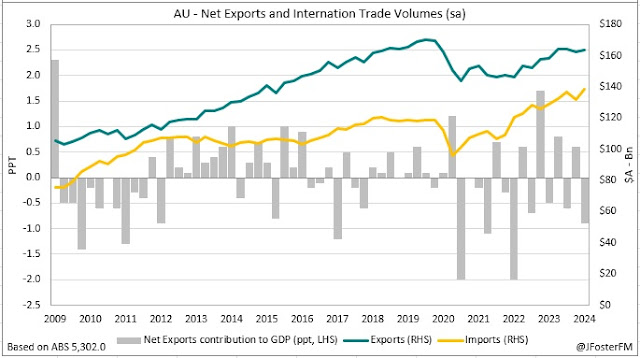Australia's current account swung back into deficit in the March quarter at -$4.9bn (-0.7% of GDP), a material downside surprise on expectations for a $5.5bn surplus. Backward revisions lowered earlier estimates of the current account surplus - materially so in the previous quarter ($2.7bn from $11.8bn) - and with the quarterly trade surplus narrowing by $6.6bn, the current account returned to deficit in Q1 - only the third deficit in the past 5 years. Net exports deducted a sizeable 0.9ppt from GDP growth in Q1.
Since peaking at around 4% of GDP in 2021, the current account has retraced, falling into deficit in Q1 (-0.7% of GDP) for the second time in the past three quarters. Backward revisions to estimates of the current account in today's report were substantial and to the downside.
A $6.1bn narrowing in the underlying trade surplus (from $23.9bn to $17.8bn) in Q1 drove the current account into deficit, with the income deficit widening modestly (-$20.8bn to -$22.3bn). The terms of trade stabilised in the quarter (0.2%) - export prices fell 1.7% and import prices were down 2% - so the narrowing in the trade surplus was predominantly driven by volume changes.
Export income declined by 1.1% in Q1 to $165.5bn (-5.1%Y/Y), reflecting lower prices (-1.7%) and a modest lift in volumes (0.7%). Key drivers behind the increase in quarterly volumes were: other mineral fuels (LNG) (8.3%) and meat (8.5%). Services exports declined (-1.1%), implying the boost to local demand from spending by tourists and students waned.
Turning to imports, spending increased by 3% in the quarter to $147.8bn, up 6.4% through the year. This was driven by a rebound in volumes (5.1%q/q) - the strongest rise in two years - following a decline in Q4 (-3.5%). Consumption goods (9.5%) rose broadly, while intermediate goods (6.8%) and capital goods (2.7%) also supported the uplift in volumes. The 2% fall in prices was an encouraging sign that more of the global disinflationary impulses from overseas (particularly in goods) will flow through to Australia in the quarters ahead.
Overall, with import volumes (5.1%) lifting much more sharply than exports (0.7%), the ABS reported that net exports will deduct a sizeable 0.9ppt from GDP growth in the March quarter, a slightly larger drag than forecast by markets (-0.7ppt).







